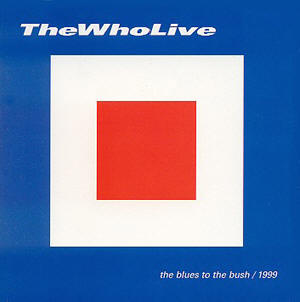
With Performances Culled From Four Different Live Shows, “The Blues To The Bush” Chronicled What Were To Be Some Of John Entwistle’s Final Major Shows With The Who.
Released by the now defunct MusicMaker.com in 1999, “The Blues To The Bush” was a live double album that documented four of the band’s final major shows with John Entwistle. The first two took place at the House Of Blues in Chicago on the 12th and 13th of November, and the other two found the ‘Oo back at home, rocking the Empire Theatre in Shepherd’s Bush during Christmas. The surviving trio (with Pete playing electric guitar from start to finish for the first time since 1982) was augmented by long-serving keyboardist John “Rabbit” Bundrick and no other than Zak Starkey on drums. Zak was actually encouraged to play the instrument as a child by Keith Moon (whom he referred to as “Uncle Keith”), and “The Blues To The Bush” was the first official product in which he could be heard drumming with the band.
The idea was that people could buy the full set or one CD or the other only, and also rearrange the tracks as they saw fit.
The tracklist itself was a predictable selection of straightahead classics along with some curveballs like “After The Fire” and “Getting In Tune” thrown in with a lot of gusto. I must admit I bought the album on their strength alone, and because there was nothing I wanted more than listening to a live version of “You Better You Bet” (I am yet to get my hands on a copy of “Join Together”).
As it turned out, the live “You Better You Bet” was the absolute highlight of an otherwise spotty set.
The two main problems are that: A) The bass is undermixed all the way through, and (I feel awful for saying it, but the truth is the truth) B) Roger’s voice sounds shot on most numbers. Compare the version of “I’m A Boy” featured on this set with the one found on “Live At Leeds”, for example. He only sounds like himself on “You Better You Bet”, and when they unleash warhorses like “Won’t Get Fooled Again”, “Baba O’ Riley” (in which Zak’s performance is second to none) and “My Generation”.
Also, the fact that customers could actually choose which songs to buy (and set down their very own running orders) leads to all tracks fading in and out. That invariably lessens the continuity of the whole album.
At any rate, “The Blues To The Bush” features an extended solo by John Entwistle on the always-astonishing “5.15”. That sets the bar somehow higher – certainly, high-enough for fans of the band to want to have the album.
Obviously, with MusicMaker.com long dead and gone, getting an original copy is harder than not laughing at Liam Gallagher’s recent comments that Beady Eyes is way better than Oasis in its prime. Yet, copies are found on eBay and related marketplaces every now and then. I have seen the amount they retail for, and I frankly wouldn’t pay that much. I got my copy right when the album was issued, and even then I was reluctant to “call it a bargain… the best I ever had”. And not even the fact that “The Blues To The Bush” has become one of the band’s final documents with John Entwistle changes that, I am afraid.
Rating: 6.5/10
